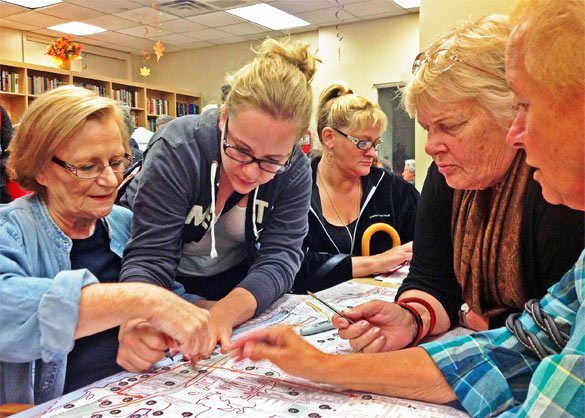Community Takes Storm Resiliency Plans Into Own Hands At NY Rising Workshop

Nearly 100 neighbors joined government officials and consultants to share their local expertise and draw up storm resiliency plans on Monday, kicking off the first in a slate of workshops sponsored by New York State to give locals a say in recovery and resiliency initiatives.
The workshops are the most public stage to-date of a $750 million initiative announced in July by Governor Andrew Cuomo, called New York Rising, aimed at recruiting locals in identifying key community assets and their thoughts on the best way to protect them from future disasters. The officials and consultants have had several private meetings with local committees of stakeholders and activists, who drew up a roster of initial proposals. The meetings – two of which were held locally this week, in Sheepshead Bay and Gerritsen Beach – then turned to the broader public to add more input and refine the plan.
One thing organizers sought to make clear is that this wasn’t a plan about rebuilding from Superstorm Sandy, but a broader community development plan seeking to strengthen the neighborhood’s residential and economic bases from future disasters.
“It’s not a Build it Back program. It’s not about insurance. It’s not about FEMA. It’s about the future of our communities,” said Jim Donovan, co-chair of the NY Rising Reconstruction Committee for Sheepshead Bay and Gerritsen Beach. “The most important thing is the future, the children, the grandchildren, the great-grandchildren. Where are they going to live? How do we make our community more sustainable, more resilient? That’s what this whole committee is about.”
After running through a presentation, the attendees split up into half a dozen different groups and received extra large maps of Sheepshead Bay and Gerritsen Beach. The maps were already marked with known assets including schools, infrastructure, hospitals and more, and the residents were asked to add anything they felt were important assets that planners should know about. They added historical relics like the Ocean Avenue footbridge, and problematic infrastructure like outdated sewage lines and below-street-level housing.
The sewage line were of particular concern for most in the room, and although the groups operated independently every group added it to the map.
“Before the tsunami came out of Sheepshead Bay [during Sandy], it came out of the sewers. The water came up the pipes and into our houses. And then the tsunami came,” bellowed one man during the meeting.
The groups also began putting forward their own proposals, including key locations for flood gates, utility infrastructure in need of elevation and more.
In addition to resiliency proposals, the groups were tasked with creating a wishlist for broader community development, including restoring the “nautical uniqueness” of the area, boosting tourism through marketing campaigns and weekend express trains, and stronger zoning laws that would prevent over-development in areas like the bungalow communities.
Although some attendees were excited by the visions put forward, others were left wondering what it had to do with storm resiliency.
“It’s a meeting to get rid of stress, that’s all it is,” said Lake Avenue resident Bob Haggerty.
Another attendee, who left in the middle of the meeting, was more succinct:
“What kind of crap is this?” she said.
Even the organizers of the meeting acknowledged that there were still many more obstacles to overcome before the plans could be put in place. The consultants hired by the state will review the proposals, and prioritize them in order of need, cost and feasibility.
The group will come out with a draft report on October 28, the one year anniversary of the storm. In November, a second public meeting will be held for more public input, and the final plan will be issued in March.
At that point, there’s little plan in place for enacting the proposals laid out. Representatives from the Department of State, which is overseeing the initiative, acknowledged that there is not yet funding for many of the ideas, and they hope to work with city agencies on the key infrastructure proposals.
Beyond that, the consultants are charged with identifying funding sources for realizing the “wishlist” items that the community has prioritized.
If you were unable to attend and would like to provide input, visit http://stormrecovery.ny.gov/nyrcr/community/gerritsen-beach-and-sheepshead-bay and submit your comments via the yellow contact button on the right.
You can also join the conversation using the hashtag #NYRising on Twitter (@NYStormRecovery). Follow the New York Rising Community Reconstruction Program on Facebook (NYStormRecovery) or go to www.stormrecovery.ny.gov. For more information, email info@stormrecovery.ny.gov.




